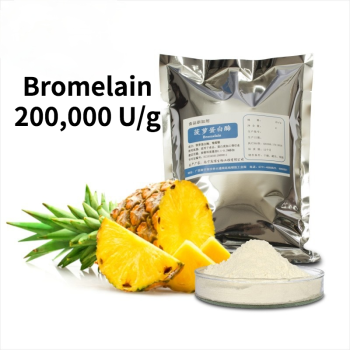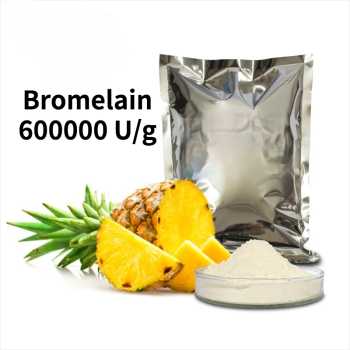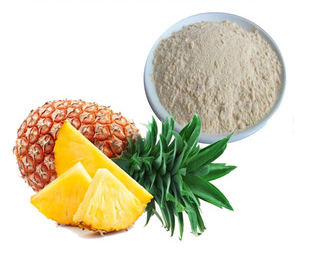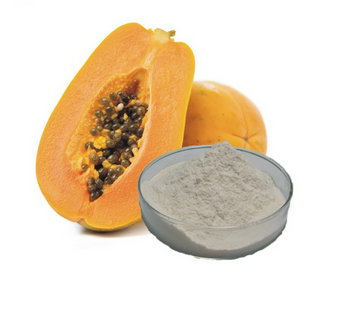
Meat Processing Enzymes such as proteases can be used to tenderize meat products and add flavor to meat products, etc. It has been widely used in meat processing. The protease enzyme of meat products will cause an internal cross-linking reaction of proteins and produce special chemical groups, which will change the taste of meat products. The internal structure of proteins, which changes the chemical properties of proteins in meat products, thereby altering their water solubility, hydration, and emulsification. This improves the quality of meat products through its functional properties such as properties.
Meat Processing Enzymes Products
The most popular enzymes in the meat industry are Bromelain and Papain.
-
Enzymes for Protein Hydrolysis
Enzima di papaina termostabile per l’idrolisi delle proteine (800000U/g)
$92.52 Add to cart
Meat plays an important role in our daily lives, almost every meal can not do without it. With the improvement of the living standard, people are no longer satisfied with the stage of eating only, but people’s needs on the taste, quality, nutrition, and other requirements of meat products have been raised. At present, the meat processing industry is constantly reforming and upgrading technology, making the industry develop in the direction of high quality and high level.
Enzyme technology applied in the meat processing field has the characteristics of green, safe, and high efficiency, which is helpful for improving the quality and efficiency of the meat processing industry. Product quality and technical improvement are of great significance.
First, we need to understand that meat tenderizers work by breaking down proteins into more digestible pieces. This process is completed by enzymes acting on one or more of the 6 amino acids found in meat. Enzyme(s) with a low degree of specificity (such as papain) break down proteins with very few specific amino acid substitutes (i.e., most proteins: soy sauce, casein, etc.). Enzymes acting on a small number of amino acids (glutamic acid and glutathione) tend to make protein highly resistant to digestion by enzymes acting on a wide variety of amino acids (such as papain). In fact, there is evidence that plant proteases are able to displace some animal proteases in the human gut and cause a potentially serious allergic reaction in humans.
Enhances the tenderness of meat products
The quality of meat depends to a large extent on its texture. Tenderness, as one of the important indicators of meat quality, has become an important factor for consumers to evaluate the quality and palatability of meat products.
Meat is rich in fibrous proteins that make the structural links in the meat tighter and make the meat less tender. The action of proteases is able to break down the fibre units in the meat, which causes the myogenic fibres to lyse, leaving the meat flabby and to enhance the meat tenderness.
Improves flavor of meat products
The use of protease can make meat products produce free amino acids and other precursors or intermediates that affect the flavor of meat products, which can accelerate the production of flavor and improve the flavor of meat products.
Adding value to meat by-products
The processing of meat products usually produces a large number of by-products or scraps, and Meat Processing Enzymes such as proteases can convert waste proteins into protein concentrates for human consumption or as feed, for example.
Meat Processing Enzymes Applications

- Two different applications
· Softening of too hard meat
· Restructuring of low-value fresh meat - In the meat industry, mainly protein-degrading enzymes were used.
- Cross-linking Meat Processing Enzymes, such as transglutaminases, were used as texture enhancers.
- Structural engineering by means of oxidative enzymes and flavor design by means of lipases, glutaminases, proteases, and peptidases are examples of new enzyme technologies in the food sector.
Meat Processing Enzymes & Functions
- Proteases (Papain, Bromelain and Ficin) play an important role in softening – proteases have been used for bone cleaning and flavor formation.
- Lipases can be used for flavor formation in sausages.
- Transglutaminase can be used in construction to adapt the structural properties of various processed and heated meat products.
- It has been reported that oxidoreductases, including tyrosinase and laccases, cross-link with meat proteins.
- L-glutaminase (l-glutaminamine aminhydrolase) plays an important role in flavour formation.
Meat Tenderization with Meat Processing Enzymes
- Texture and tenderness are the most important characteristics of meat products.
- The Meat Processing Enzymes used in meat tenderizing are the vegetable enzymes papain, bromelain, and ficin.
- If the maturation time of high-quality meat cuts is to be shortened
· The main effect of protein hydrolysis should be related to myofibrillar proteins.
If improving the tenderness of low-grade meat cuts or connective tissue meat - In most cases, collagen should be the target of proteolysis.
Vegetable proteases, which are mainly used to soften the meat, have a more active effect on other meat proteins than on collagen. - The softening of collagen-rich connective tissue leads to extensive hydrolysis of non-collagenous proteins.
- The result is a too soft (tender) meat
· To soften meat cuts with high connective tissue content - An enzyme with pronounced activity against connective tissue but limited activity against myofibrillary proteins should be used.
Enzymatic Generation of Flavor in Meat Products
- The taste of raw meat is rather bland.
It contains non-volatile components which are essential flavor precursors. - The most important enzymatic reactions that influence the taste of meat or the formation of flavor precursors are proteolysis and lipolysis.
Proteolysis and Lipolysis in Meat Flavor Development
- Proteolysis takes place during the maturation process.
It is mainly catalyzed by the body’s own enzymes, such as cathepsins and trypsin-like peptidases as well as proteases. - Glutaminase plays an important role in the production of sausages.
“Concerning the deamidation of glutamine, which produces ammonia and a taste of umami. - Umami can be described as a pungent or brothy taste with the ability to enhance other flavors.
- Lipolysis is associated with the formation of the aroma of fermented sausages.
- Phospholipases and lipases hydrolyze phospholipids and triacylglycerols to form free fatty acids.
- The unsaturated fatty acids are then oxidized to volatile aromatic compounds.
· They lead to the formation of aliphatic hydrocarbons, alcohols, aldehydes, and ketones.
· The alcohols react with the free fatty acids to form certain esters.
Structure Engineering By Cross-Linking Enzymes
- The functional properties of meat proteins can be modified by cross-linking enzymes.
- These enzymes are used to bind pieces of fresh meat and to adapt the structural properties of various processed meat products.
- The main target protein in meat for cross-linking enzymes is the myofibrillar myosin protein.
- Cross-linking enzymes are generally able to gel and thus influence the texture of meat gels.
- Transglutaminase is the most important cross-linking enzyme used industrially to modify meat proteins.
Restructuring of Unheated Meat
Traditionally, salt and phosphates with heat treatment were used to bind the pieces of meat together. Unheated meat products are usually frozen to improve the binding. Today’s consumers demand fresh, unfrozen meat, and lower salt content. Transglutaminase has been found to improve the firmness of restructured meat protein gels, with or without the addition of salt and phosphates.
Processed Meat Systems
- The effects of transglutaminase have been used to
· isolated meat protein systems and model meat products, which aim to improve texture properties - The transglutaminase-catalyzed formation of additional covalent bonds in the structural protein of meat leads to firmer gel structures.





